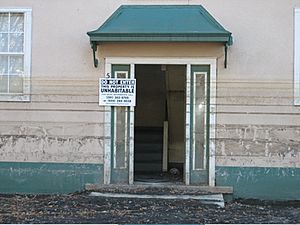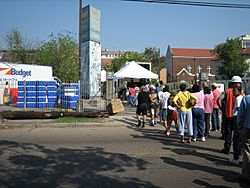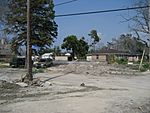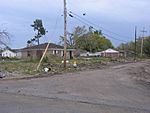Reconstruction of New Orleans facts for kids
The reconstruction of New Orleans is about rebuilding the city of New Orleans after Hurricane Katrina caused a lot of damage on August 29, 2005. The storm made the city's protective walls, called levees, break. This released billions of gallons of water, causing huge floods in New Orleans and nearby areas.
About 80% of all buildings in Orleans Parish were damaged by water. More than 204,000 homes were either damaged or completely destroyed. Over 800,000 people had to leave their homes. This was the biggest number of people forced to move in the United States since the Dust Bowl in the 1930s. The total cost to repair the damage was about $125 billion.
Rebuilding was slow because of problems with government groups like the United States Army Corps of Engineers and Federal Emergency Management Agency (FEMA). Other help groups also gave aid. By the middle of June 2006, New Orleans was already holding big meetings and inviting tourists back.
Contents
Rebuilding the City
By Monday, September 5, 2005, power started to come back on in the main business area of New Orleans. By Tuesday, September 6, 2005, the Port of New Orleans, which is the biggest U.S. port for cargo, could take in and help ships carrying aid. It was thought that regular shipping would take at least two more weeks to start again.
Fixing Levees and Pumps
The United States Army Corps of Engineers fixed 55 broken levees, including those at the Industrial Canal, 17th Street Canal, and London Avenue Canal. They started these repairs soon after the storm. They are still working to make sure the city is safer from future floods.
Restoring City Services
Tests showed that the floodwaters were not unusually dirty. In March 2006, the Louisiana Department of Environmental Quality and the U.S. Environmental Protection Agency (EPA) said that all parts of New Orleans were safe. They found no contaminated soil and the air quality was clean.
Water and sewage services slowly came back. The first part of the city to have its "boil water" warning lifted was the higher ground along the river, from the French Quarter to old Carrollton, on October 6, 2005. The last part of the city to get this warning lifted was a section of the Lower 9th Ward, on October 9, 2006.
Should the Government Pay?
Some people, like former Speaker of the House Dennis Hastert, wondered if the government should pay to rebuild New Orleans. Others believed that New Orleans's special culture and history are very important to the United States, just like Venice is to Italy. They felt that not rebuilding the city would be a huge loss.
The Times-Picayune newspaper wrote an editorial on its front page asking for national help. Some argued that since the United States Army Corps of Engineers had been in charge of the levee system since the Great Mississippi Flood of 1927, and most of the damage was from levees breaking, the government should be responsible for rebuilding. Senator Mary Landrieu said that Louisiana's offshore oil leases bring billions of dollars to the government. She argued that some of this money should be used to fix wetlands and improve flood control for South Louisiana to handle strong storms.
Rebuilding and Community Life
Frederic Schwartz, an architect chosen by the people of New Orleans, explained how rebuilding the city could also improve social fairness and community life. He said that after a disaster, cities have a chance to rethink how they are planned. It's a chance to focus on caring for the environment, being fair to everyone, building strong communities, and helping poor people get good, affordable, and lasting homes.
Schwartz's team worked on District 4, which had the most public housing. He made sure to involve the residents and the community in the planning. The goal was to design new housing that would look and feel like the old neighborhoods, mixing modern styles with traditional ones.
Help from Aid Groups
Many aid groups helped people return. The American Red Cross set up many relief centers by early October. These centers gave out hot meals, packaged food, bottled water, diapers, mops, and dust masks. The Salvation Army also had many places giving out food. Temporary free clinics offered some medical care. By the end of 2005, these centers started to close down. Red Cross meals continued on a smaller scale into 2006 from trucks visiting the hardest-hit areas.
The Southern Baptist Convention sent food units to New Orleans and the Mississippi Gulf Coast right after Katrina hit. They started a project called Operation Noah Rebuild, which hosted thousands of volunteers. These volunteers helped rebuild homes in New Orleans and nearby areas. First Baptist Church of New Orleans worked with Habitat for Humanity on the Baptist Crossroads Project to rebuild homes in the Upper Ninth Ward.
Food Not Bombs also helped by providing food early on. A community kitchen was set up first in Washington Square, then moved to a park, and later closed. Many church groups and smaller charities also set up aid stations for a time.
Common Ground Collective had two relief centers in the Ninth Ward of New Orleans. They provided food, clothing, and tools. They also helped clean out damaged houses.
The Church of Jesus Christ of Latter-day Saints brought in lots of food and water for its members and other residents. Thousands of church members came on weekends to help clean up, clear out houses, and cut down fallen trees. The church also offered mental health help and job search assistance to everyone.
Habitat for Humanity has been building homes quickly since the storm. They first helped clean out houses, but then went back to their main goal of building homes for people in need. Catholic Charities also had many volunteers repairing damaged houses and churches. Camp Hope in Violet, LA housed volunteers helping in St. Bernard Parish since June 1, 2006.
Build Now is a non-profit group that helped New Orleans families return home. They built new, elevated houses on lots damaged by the hurricane. These homes looked like traditional New Orleans houses. Build Now helped many families move back, building in areas like Lakeview, Gentilly, and the Upper and Lower Ninth Ward.
The Jazz Foundation of America helped New Orleans musicians. They paid the first month's rent for new homes, gave away nearly $250,000 worth of instruments, and offered free advice and legal help. They also created a program to give jobs to musicians by having them perform free concerts in schools and nursing homes.
People Moving Back Home
People have been moving back to New Orleans steadily, but slowly. It wasn't as fast as some hoped, nor did the city become a "ghost town" as some feared. In early 2006, experts thought the population would only be a little more than half of what it was before the storm. However, by July 2007, about two-thirds of the original population (around 300,000 residents) had returned.
Even in 2009, many homes and owners were still struggling. Groups like the Louisiana Disaster Relief Foundation and the United Saints Recovery Project continued to help homeowners rebuild.
Areas with little or no flooding were the first to officially reopen. Utilities were restored there, and many residents and businesses returned quickly.
Flooded areas had more problems. The city didn't have a full plan for these areas. Thousands of property owners cleaned out and repaired their homes, even in the lowest parts of town. Workers from other states and countries came to help with demolition and rebuilding. Some stayed in hotels, others in trailers and tent cities set up in parks.
In September 2006, some areas like the Lower Ninth Ward and Gentilly still looked very damaged. However, thousands of truckloads of debris were removed from these neighborhoods. Hundreds of houses that couldn't be saved were torn down. Work on cleaning out and repairing homes has been constant since the city reopened.
Many New Orleanians lived upstairs in their homes while the flood-damaged downstairs was being fixed. Often, the downstairs was stripped down to the wall joists.
The United States Army Corps of Engineers started the "Blue Roof Program." They put blue tarps over damaged roofs to keep out rain until permanent repairs could be made. Thousands of blue tarps were seen across the city. However, some rules meant that not all residents could get this help. Also, some contractors hired by the Corps only fixed easy, low-pitched roofs.
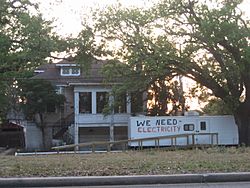
Seven months after the storm, two-thirds of the requested FEMA trailers had been delivered. These trailers were meant for short-term emergency housing. However, many could not be used, or if they were, they didn't work properly. There were often weeks or months of delays in connecting electricity and water to the trailers.
In June 2006, the State of Louisiana hired a company to remove thousands of abandoned cars left in New Orleans after Hurricane Katrina.
Different Recovery Speeds
Rebuilding was fastest in the areas least damaged by the storm. These were mostly parts of the city built before 1900. They were on higher ground along the river, like Old Carrollton, Uptown, the Old Warehouse District, the French Quarter, Old Marigny, and Bywater. Some areas along natural ridges, like Esplanade Ridge and Bayou St. John, also recovered quickly. Most of these older areas had no flooding or avoided serious damage because older homes were built higher up. Another high area was the Lake Shore developments, built higher from mid-20th century dredging.
Because of how the storm moved, the West Bank part of the city, Algiers, was saved from flooding. It was the first part of the city to officially reopen to residents.
In nearby Jefferson Parish, the West Bank communities also avoided flooding, only getting some wind damage. On the East Bank, parts of Metairie and other Jefferson communities had some flooding. But because their levees didn't break, it was much less severe than in Orleans Parish.
A higher percentage of white residents returned to their homes than black residents. This was partly because planners were not willing to rebuild low-income housing. Some former residents were told by FEMA workers that moving back was not realistic because parts of the city were not being rebuilt. This caused many people who wanted to return to New Orleans to have to move elsewhere.
Large areas of the city's public housing were planned to be torn down. This caused strong protests from some people, including architecture critic Nicolai Ouroussoff.
Homeless People
One big challenge for New Orleans was the large number of homeless people after Katrina. The number of homeless people in New Orleans doubled to 12,000 by mid-2007. With a population of 300,000, this meant 1 in 25 people were homeless. This was a very high number, almost three times more than in any other U.S. city. Most of the homeless were people who had to leave because of Katrina. They returned to higher rents or didn't get enough help from the government's temporary housing programs.
Some workers who came to New Orleans for rebuilding jobs also became homeless after losing their work. To make things worse, the number of beds for homeless people in the city went down from 2,800 before the storm to 2,000 by May 2008.
In January 2009, the New Orleans Legal Assistance Corporation's Homeless Department looked at the numbers again. They found that the number of homeless people had gone down by 64% since the last survey two years before.
Tourism and Events Return
The American Library Association held its yearly meeting in New Orleans in June 2006. About 18,000 people attended, making it the first big city-wide meeting in New Orleans since Hurricane Katrina. The National Association of Realtors also held their yearly meeting in New Orleans in November 2006, bringing 30,000 people. Other large conventions also returned in 2007. The Essence Music Festival came back to New Orleans in July 2007 after being held in Houston in 2006. Several national travel guides have again listed New Orleans as one of the top places to visit in the country.
The Bayou Classic, a traditional football game between Southern University and Grambling State University, returned in November 2006. The National Football League showed its support for the city by bringing back the New Orleans Saints. The National Basketball Association also showed its support by bringing back the New Orleans Hornets. The Hornets played in both New Orleans and Oklahoma City in 2005–06 and 2006–07, then fully returned for the 2007–08 season. New Orleans hosted the 2008 NBA All-Star Game, which brings in millions of dollars. Tulane University hosted the first and second rounds of the 2007 NCAA Men's Division I Basketball Championship.
The Superdome has hosted several college football bowl games since. The New Orleans Bowl started again in December 2006. The Sugar Bowl and the 2008 BCS National Championship Game took place in January 2008. New Orleans hosted the Super Bowl in 2013 for the first time since Hurricane Katrina. In February 2010, the New Orleans Saints won Super Bowl XLIV.
Major yearly events like New Orleans Mardi Gras and the New Orleans Jazz & Heritage Festival were never stopped, as they happen at other times of the year.
Images for kids
See also
 In Spanish: Reconstrucción de Nueva Orleans para niños
In Spanish: Reconstrucción de Nueva Orleans para niños


